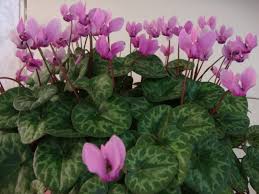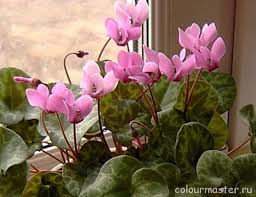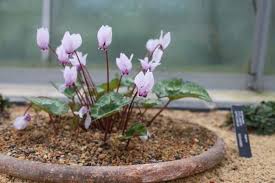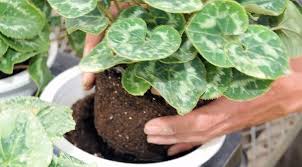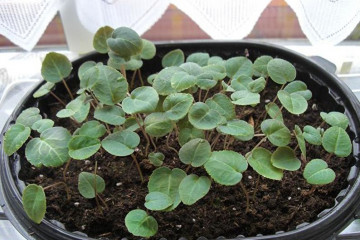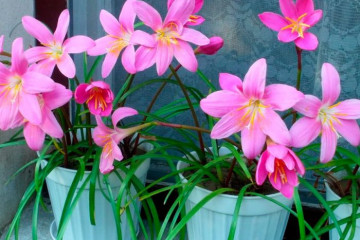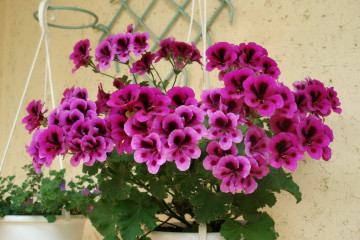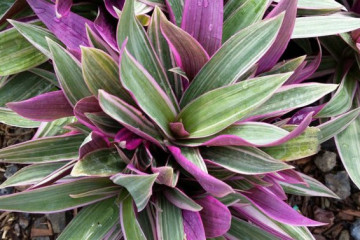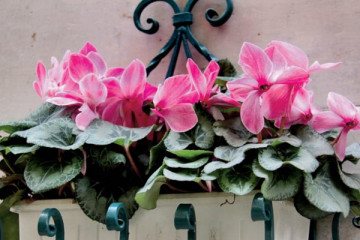Alpine violet flower care at home
Content:
Alpine violet (cyclamen) is a spectacular plant that blooms when there is snow outside the window. That is why the flower got its name. The birthplace of cyclamen is the mountains. Breeders have bred many new varieties that differ in the shape of the leaves, patterns on them, and color of flowers. The Alpine Violet can be grown as an indoor or garden plant.
What does an alpine violet look like?
Cyclamen grows from tubers, bush. An adult plant is up to 30 cm tall. The leaves are arranged on long, reddish-brown cuttings. Flowers are five-petal, elongated on long flowering stems.
Breeders have bred 22 varieties of alpine violets, which can be divided into two types:
- purple (European - Cyclamen purpurascens);
- Persian (Cyclamen persicum).
The varieties shown in the table are suitable for home cultivation.
| Cyclamen variety | Plant size | Flowering period | Description of the flower |
| Umbrella, Persian, hybrid | standard | December - May | small pink flowers, unusual shape, pink |
| Lulu, persian, hybrid | up to 30 cm | blooms for 4 months | red flowers, fringed edges of petals |
| Victoria, persian, hybrid | average | December - May | double petals, two-color: white at the base, crimson top |
| Mauris Dryden, Kosky | standard | December - March | different shades, the base of the petals has a thick rich tone |
| Roseum, kosky | average | December - March | bright pink with a dark eye |
To ensure the correct development of a flower at home, you need to know which variety it belongs to.
The history of the popularity of cyclamen began in the small Canadian town of Delhi. A flower shop was opened there when the economy fell sharply. The first flower that was offered to buyers was a cyclamen taken from the mountains. Now the Farmley Flowers flower shop has become a huge greenhouse, in which hundreds of cyclamens bloom every fall, the most unusual specimens of different colors.
Features of caring for alpine violets at home
When looking at a gentle cyclamen, it seems that he is capricious and loves warmth. But it is not for nothing that the first word in the name is “alpine”. The flower prefers cold and light, therefore, there is no place for a flowerpot with an alpine violet on the windowsill, under which the central heating passes. It must be placed in the coldest room or on the balcony.
Temperature
In nature, the alpine violet releases flower stalks as soon as the mountain glades are free of snow. In an apartment, the flower develops well at a temperature of 10-15 degrees. In the summer, it is necessary to remove the flowerpot from bright sunlight.
Lighting
Mountain violet loves light, but direct sunlight is destructive for it. Most suitable will be windows located on the east or west side of the horizon. There is not enough light on the northern windows of the alpine violet. In the southern rooms, the flower can be placed farther from the window.
Watering
You need to water the flower with soft, settled water. The water temperature should be lower than the room temperature. After the color has subsided, watering is reduced.
Spraying
Before the buds bloom, grandmother's cyclamen can have a cool shower - spray. This procedure increases the humidity in the room and lowers the temperature.
Priming
The soil for planting a handsome Alpine man is a mixture of several components, which is easy to prepare yourself.
The following ingredients must be mixed:
- humus (part 1),
- sand (1 part),
- peat (1 part)
- sheet soil (2 parts).
Experienced growers say that peat can be excluded.
Top dressing
You need to feed the bush before flowering, when it grows leaves. You can take mineral or organic fertilizers.
When feeding, you must observe the frequency - once a week.
When and how an alpine violet blooms
Most species of alpine violet throw out their color with the arrival of autumn. For lush flowering, the specimen also requires a large amount of nutrients, a certain air temperature, humidity and lighting.
Cyclamen flowers are different in size and color palette - from pale whitish to burgundy with a dark tint, purple.
The petals are bent back and resemble the wings of a butterfly. The edges of the petals can be simple, carved, pointed with a fringe, with a multi-colored border.
Different varieties of indoor cyclamen do not bloom at the same time. The Persian cyclamen pleases with its flowers in winter, and the European one blooms in summer. If the Persian can throw out peduncles at a temperature of + 10 ° С, then the European cyclamen will bloom profusely, even if the thermometer is + 23 ° С.
The life cycle of different varieties of alpine violets is the same: the appearance of leaves, single flowers, lush flowering, drying of the shoots, the accumulation of substances necessary for the dormant period.
How the alpine violet reproduces
Florists propagate dryad (this is another name for alpine violets) in two ways - by seeds and cuttings.
Germinating seeds
Growing alpine violets from seed is a lengthy process.
First you have to make the flower bear fruit, and for this you need to pollinate the plant. At the beginning of the process, select a flower and tap on it. The pollen will scatter and settle on other flowers.
After pollination, after a while a box will appear. As soon as it begins to slope down, it should be plucked, dried and the seeds should be checked for germination. To do this, make a 5% sugar solution and dip the seeds into it. The viable seeds will sink to the bottom.
Peat tablets are used for seed germination.
Rooting cuttings
Alpine cyclamen can be propagated by a rosette at the root. The growth should be pinched off and planted in new soil. It is difficult to propagate a plant by cuttings from leaves.
A florist who is keen on breeding cyclamens can try all methods of propagation and apply the most successful one in his practice.
Transplant after purchase - guide
Alpine violet (Cyclamen) is not recommended to be replanted immediately after purchase.
A year later, as soon as the first shoots appear over the tuber, start transplanting and follow the description:
- the flowerpot should be 2 cm larger than the bulb;
- soil, which is a mixture of peat, sand, crushed sphagnum, vermiculite and charcoal, can be bought at a flower shop;
- expanded clay will be needed for drainage;
- a thick layer of drainage, substrate is poured into the flowerpot;
- the cyclamen tuber is placed in a flowerpot (about 1/3 of the tuber remains above the ground);
- soil is poured and slightly pressed down;
- the transplanted plant is watered with a weak solution of manganese.
Top dressing of the plant can be carried out only after the young leaves have begun to grow.
Possible problems in growing alpine violets
Alpine violet requires careful home care. She is very sensitive to care errors.
Diseases
There are many diseases due to which a representative of the indoor flora can lose its attractiveness.
The dryak can abruptly throw off the leaves - it means it is hot in the room, the humidity is insufficient.
Flower rot can develop from moisture ingress. In this case, it is recommended to remove drooping shoots, treat the specimen with a fungicide.
Pests
The European violet can be attacked by pests.
- An elephant beetle, settling on a flower, gnaws at the leaves, and tubers will become food for its larvae. It is difficult to deal with such a pest.
- You can fight the scabbard (aphids): remove adults and their larvae, treat the leaves with soapy water and insecticide.
Other problems
Many growers are worried when the leaves of a plant turn yellow massively. This is normal: the flower is preparing for a state of rest. The plant can wither due to lack of space in the flowerpot, due to depletion of the soil. It happens that the peduncles are short. In this case, you need to increase watering.
Cyclamen can delight not only in the interior of the house. Growers are increasingly putting the Alpine violet on flower beds. It looks great on an ivy-covered balcony. The composition of cyclamen in combination with ornamental herbs in a hanging planter makes the terrace exquisite. Blooming cyclamen is an expression of all tender feelings. If you take proper care of the flower, it will amaze with its exotic beauty for many years in a row.
